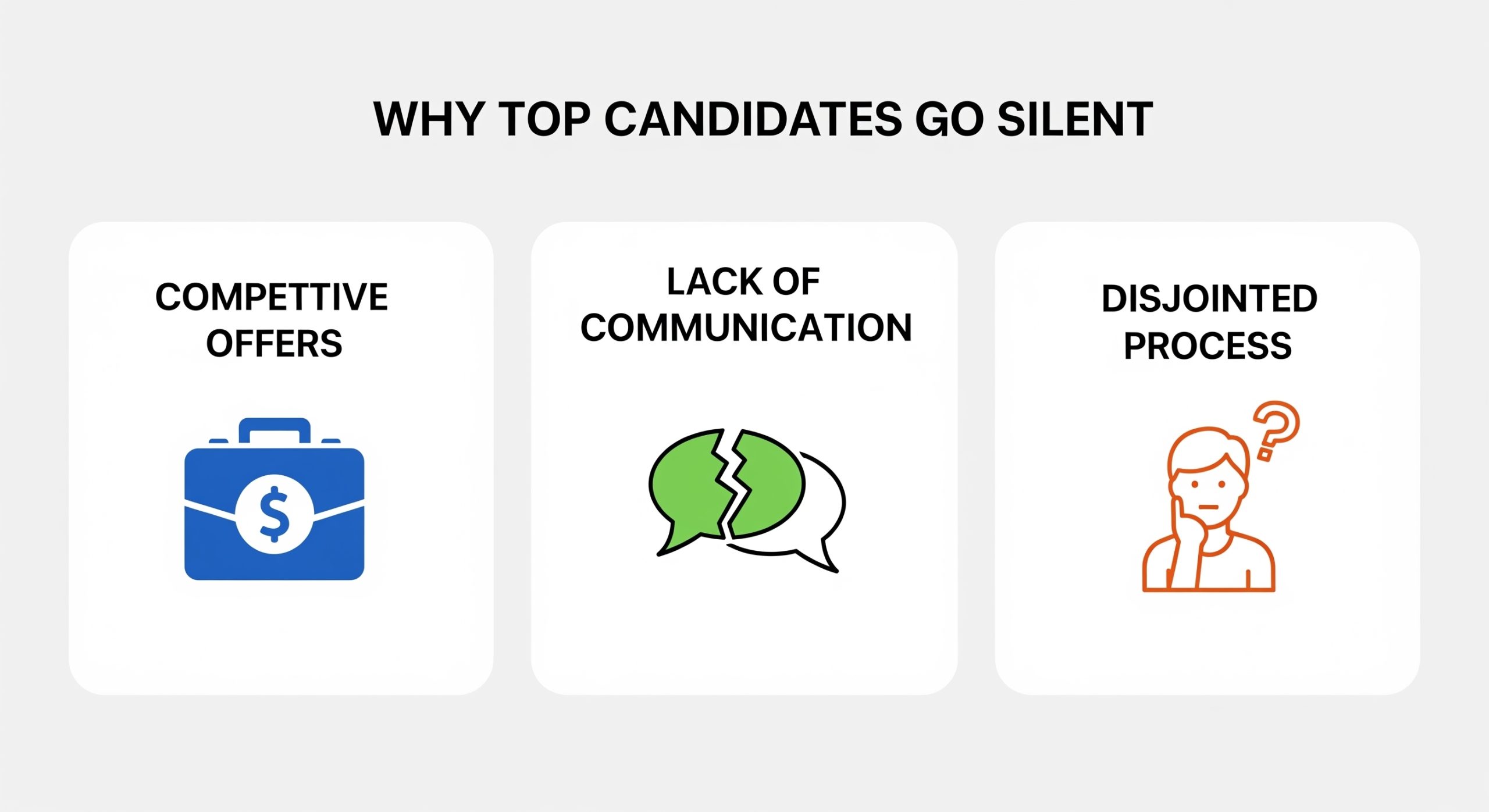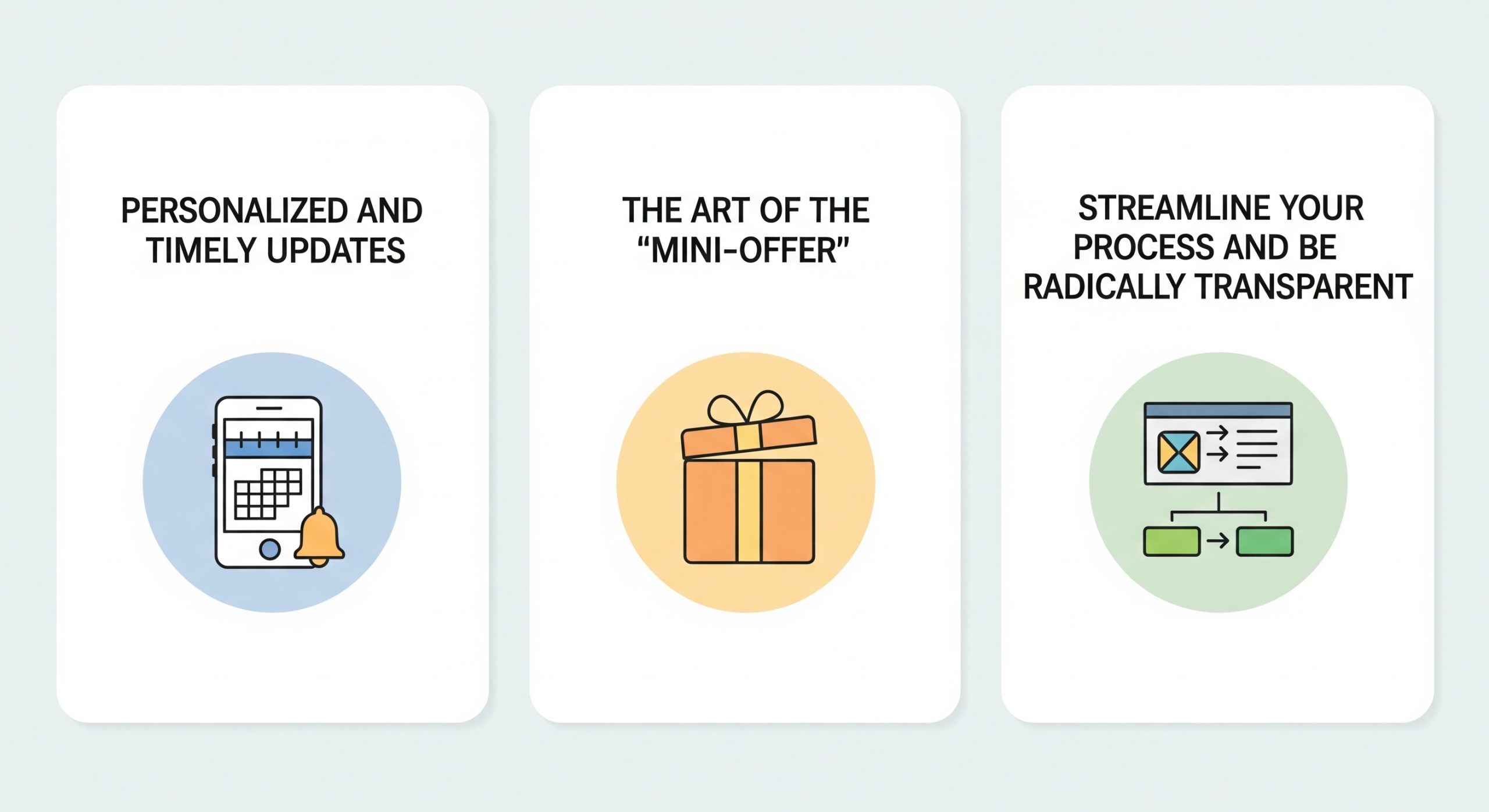Any hiring manager or recruiter has experienced the familiar and annoying situation where a promising candidate, just after a fantastic interview, abruptly stops talking. Calls end up in voicemail, emails remain unanswered, and a promising connection turns into a frustrating void. Candidate ghosting is more than just a small annoyance; it’s a sign of a highly competitive labor market where top talent has a distinct edge. Companies must restart their search and run the risk of settling for a less-than-ideal hire if they lose a top candidate in the middle of the process, which costs time, money, and momentum.
A single-channel application process is a thing of the past. The best candidates of today are not merely passive applicants; rather, they are engaged members of a dynamic market who frequently manage several opportunities concurrently. It’s not always a sign of disinterest when they remain silent. Rather, it’s frequently an obvious indication that there is a problem with your hiring procedure. You can stop ghosting and create a more robust and efficient hiring process by knowing the main causes of candidates’ disappearance and implementing proactive, candidate-centric tactics. In addition to offering specific, doable tactics to re-engage and acquire the talent your team needs to succeed, this guide delves into the underlying causes of candidate ghosting.
The Root Cause: Why Top Candidates Go Dark
Before you can solve the problem of candidate ghosting, you have to understand it. The reasons behind a candidate’s sudden silence are rarely malicious. Instead, they’re almost always a rational response to a hiring process that doesn’t meet their expectations.

1. The Allure of a Competitive Offer
Perhaps the most frequent cause of candidate ghosting is this. Top candidates are not waiting for a single company to decide in a talent-driven market. When they receive a competitive offer, whether it’s a higher salary, more extensive benefits, a more exciting job title, or a better work-life balance, they frequently accept it right away because they are probably nearing the end of a process with multiple other companies. They might not feel compelled to notify you that they are no longer in the running if there is no official commitment or continuous communication with your business. The silence closes the loop quickly, but impersonally.
2. The Disconnect of a Lack of Communication
Let’s say you recently had a fantastic interview with a business you’re enthusiastic about. A week of radio silence greets you after you depart with optimism. Then another. One of the main causes of candidates losing interest and vanishing is this lack of communication. A disorganized and unappreciative hiring process is indicated by lengthy intervals between interviews, ambiguous “we’ll be in touch” statements, or a failure to provide even small updates. Assuming that if the company is unable to communicate effectively during the hiring process, they will probably be unable to communicate effectively once they are employed, candidates interpret this silence as a warning sign. They move on to businesses that consistently and openly communicate that they value their time and interest.
3. The Uncertainty of a Disjointed Process
The culture of your business is reflected throughout the hiring process, from the first application to the last offer. Uncertainty is created and a top candidate may be turned off by a fragmented process that is full of last-minute cancellations, delays, and interviews without a clear agenda. A candidate will doubt the organization’s stability and vision if they believe the company is unorganized, unsure of its goals, or indecisive. Subtle warning signs like a hurried or impersonal interview, a lack of enthusiasm on the part of the hiring manager, or a job description that doesn’t fit the interview conversation can also turn them off. These periods of uncertainty serve as strong incentives for a candidate to politely and unexplainably withdraw from the process.
The Proactive Playbook: How to Win Back Top Talent
You can’t control every external factor, but you can control your own process. By taking a proactive approach, you can create a seamless and engaging candidate experience that not only prevents ghosting but also helps you secure top talent.

1. The Power of Personalized and Timely Updates
A personalized, human touch is the most powerful weapon in your toolbox in a world full of automated, generic emails. Even in the absence of significant news, candidates are kept interested and feel appreciated by timely, personalized updates. Saying “We’re still moving forward with the process and will have an update for you by the end of the week” via phone, text, or email goes a long way. It shows that you value their time and that you haven’t forgotten them.
However, for a recruiter balancing several responsibilities, this degree of regular, one-on-one communication can be extremely time-consuming. Here’s where cutting-edge AI solutions come in quite handy. The majority of this communication can be handled automatically by a conversational AI recruiter. Consider an AI chatbot that is capable of:
- Provide Instant Status Updates: A candidate can simply ask “What’s the status of my application?” and receive an immediate, accurate response.
- Answer Common Questions: The chatbot can answer frequently asked questions about the company culture, benefits, or the next steps in the process, freeing up the recruiter’s time for more strategic tasks.
- Schedule and Confirm Interviews: The AI can handle the logistical nightmare of scheduling, sending reminders to both the candidate and the hiring team, and ensuring everyone is on the same page.
- Automate Follow-Ups: With an AI assistant, you can set up automated, personalized check-ins to ensure no candidate is ever left in the dark.
This is the kind of efficiency and candidate-centric approach that a tool like CloudApper AI Recruiter can provide. By leveraging a conversational chatbot, you can maintain a constant, positive dialogue with every candidate, making them feel like a priority. You can learn more about how this technology can transform your hiring process by visiting the CloudApper AI Recruiter page.
2. The Art of the “Mini-Offer”
A “mini-offer” is a small, thoughtful gesture you can extend to a top-tier candidate to keep them engaged and excited about your company before the official offer is even on the table. It’s a way of showing you’re serious about them and a powerful signal that your company values its employees.
- Offer to Connect with a Peer: Invite them to a low-pressure, virtual coffee with a potential future teammate. This gives them a chance to ask questions and get a genuine feel for the team dynamics.
- Send a Branded Swag Box: A simple box with a company t-shirt, coffee mug, and a personalized note can make a lasting impression. It’s a tangible gift that says, “We’re already picturing you as part of the team.”
- Cover the Cost of a Relevant Course: If you know a candidate is working on a specific skill, offer to pay for a relevant online course or book. This demonstrates your investment in their professional growth and shows that you’ve been paying attention to their career goals.
Mini-offers don’t have to be expensive, but they do have to be sincere. They are a powerful way to make your company stand out from the competition and keep a candidate from even considering other offers.
3. Streamline Your Process and Be Radically Transparent
A clunky, slow, or disorganized hiring process is a major turn-off. Top talent values efficiency and clarity. The most effective way to combat this is to streamline your process and be radically transparent about it.
- Set Clear Timelines: At the end of every interview, tell the candidate exactly what the next steps are and when they can expect to hear from you. Then, follow through on that promise.
- Standardize Your Interviews: Ensure every interviewer is on the same page with a clear agenda and purpose for the conversation. A cohesive, professional interview experience shows that your company is organized and intentional.
- Provide Constructive Feedback (When Possible): Even if a candidate isn’t the right fit, providing a brief, constructive note about why can leave a positive impression. It’s a sign of respect for their time and effort and can save your employer brand from negative reviews.
Again, this is where AI can revolutionize your approach. Tools like CloudApper AI Recruiter can standardize communication flows, automate scheduling to reduce back-and-forth emails, and provide a single source of truth for the entire hiring timeline. This helps you build a process that is not only efficient for you but also transparent and respectful for the candidate.
The Cost of a Broken Process
A poor hiring procedure has major long-term repercussions in addition to the immediate annoyance of losing a candidate. Tens of thousands of dollars may be spent on training, lost productivity, and recruitment costs as a result of a poor hire. Your competitive edge may be weakened if you lose out on the best candidates available due to an ineffective hiring cycle.
Additionally, a bad applicant experience can harm your employer brand for good. A single negative experience can reach a large audience in the era of social media and online review platforms. Top candidates who experience poor treatment or are ghosted will frequently tell their stories, discouraging other competent professionals from applying to your organization in the future.
Although candidate ghosting is a frustrating reality, it can be lessened by adopting a different viewpoint. Consider it a chance to enhance your hiring procedure rather than a problem with the applicant. You can create an experience that keeps top talent engaged from beginning to end by emphasizing personalized communication, being radically transparent, and utilizing contemporary tools like an AI recruiter. Securing the best talent and creating a robust, resilient organization now require adopting a candidate-centric mindset and leveraging technology to support it.
